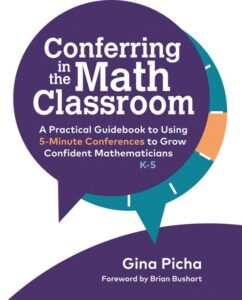Using Conferences to Grow Mathematicians
Conferring in the Math Classroom: A Practical Guidebook to Using 5-Minute Conferences to Grow Confident Mathematicians
By Gina Picha
(Stenhouse Publishers, 2022 – Learn more)
Reviewed by Kathleen Palmieri

Much like a reading conference, math conferences are brief conversations that help us as teachers “understand our students’ thinking and provide opportunities to observe our students as they engage in mathematics.” (pg. 4)
Picha writes about different types of math conferences, but offers three essential elements in any math conversation: listening and observing, naming students’ strengths, and encouraging students to share their ideas.
Math vs. literacy conferences

The skill with which the teacher asked questions, the encouragement she provided, as well as the strategy of going back and rereading the writing and sharing the anchor chart again, stuck with Picha.
“Many of the teaching moves Deb used in her writing conference also support mathematicians. Both writing and math conferences involve deep listening and observation work. They also share the same overarching goals of supporting students’ long-term growth and helping students to develop a love and appreciation for the craft of writing and mathematics.” (pg. 16)
The book’s table “Comparing Writing and Mathematics Conferences” helps to illustrate the differences between writers and mathematicians. Most notably:
- When working with writers a teacher might encourage the use of a mentor text for a student to study and imitate a writing style.
- In working with math students the teacher might encourage them to collaborate with peers to share different strategies in problem solving. (pg. 17).
The shared similarity of both is that teachers look for strengths that can help to create a teaching point for that student.
Maximizing math conferences
In chapter three Picha shares her two goals for successful conferencing and the types of math conferences she recommends.
The goals are “Understanding students’ needs and interactions” and “Nudging students toward deeper mathematical understanding and increased engagement within the math community.” (pg. 23) She provides authentic examples of math conferences which help to demonstrate what is observed, what is noticed, type of response and the reason for that response.
Picha shares two conference structures. Working within the task uses the conference to “Notice and understand, uncover student thinking, name and reinforce, and invite sharing.” She also examines the components of conferring Beyond the task which differs in that the teacher will “Nudge thinking beyond the task” and “Invite conjecture and sharing.”
“Mathematical Conjunctures” is a term that Picha uses to describe students’ “mathematical hypothes(es) that they believe to be true but have not yet proven. Often conjunctures develop from the patterns that students notice with a problem or across problems.” (pg. 32) In basic terms, these are students’ ideas that can help provide further discussion, creating a starting point for new discoveries.
The use of questioning
Chapters four and five delve into the use of questioning and provide a glimpse into Picha’s former fifth grade classroom.
Offering more examples of students in action, Picha discusses the questioning technique of “Funneling,” which is to use a set of questions to help lead the students to the correct solution, giving limited attention to student ideas that are going in the wrong direction.
She includes the intended and unintended results of “Asking Questions that Funnel Student Thinking.” She also provides a “Questioning Support Document for Math Conferences” and offers the components of the two types of questioning as well as examples.
Asset-Based Conferring
Part three of this book discusses “Asset-Based Conferring” such as conferring from students’ strengths, noticing and responding to students’ errors, and addressing those errors during the conference. Her table of “Strengths to Name and Reinforce” is broken into six parts: collaboration, organization, representations, generalizations, creative choices, and dispositions. Picha describes analyzing student work samples to find strengths as well as to help foster a positive math identity.
In addition, she offers guidance in working “Beyond the Task” and nudging student thinking using questions and sentence starters. She also takes a deeper dive into “conjunctures” and how to invite students to make conjunctures, offering “Examples of Student-Made Conjunctures.” (page 84).
Preparing the Class to Confer
Part four offers planning for success, asking the question, “What should you consider before conferring?” Discussed within chapter eight is the importance of “Building a Math Community that Fosters Positive Math Identities.” Rounding out this part is chapter nine, “Planning for Data Collection and Analysis,” and chapter ten, “Planning for the Tricky Parts.”
The tricky parts include the “I work alone” and the “I’m done” which is when early finishers complete a task before the teacher is done conferring. Picha offers some ideas of ways to extend the students’ math thinking, such as an anchor chart that offers math ideas that help check in with students.
Finally, Picha includes three appendices with resource charts: “If/Then Charts,” “Conferring Scenario Cards” for grades K-5, and “Conferring Notes Template.”
Conferring in the Math Classroom offers plentiful advice, examples, and resources to hold math conferences using the three essential elements: listening and observing, naming students’ strengths, and encouraging students to share their ideas. This is a practical resource with sound ideas that can be easily implemented to build the habit of conferring in the math classroom in ways that advance student success.
Kathleen Palmieri is a National Board Certified Teacher and NBCT Professional Learning facilitator. She is a fifth grade educator in upstate New York who reviews and writes regularly for MiddleWeb. With a passion for literacy and learning in the classroom, she participates in various writing workshops, curriculum writing endeavors, and math presentations. As a lifelong learner, she is an avid reader and researcher of educational practices and techniques. Collaborating with colleagues and globally on Twitter @Kathie_Palmieri and expanding her education adventures at www.kathleenpalmieri.com are ongoing practices.






























